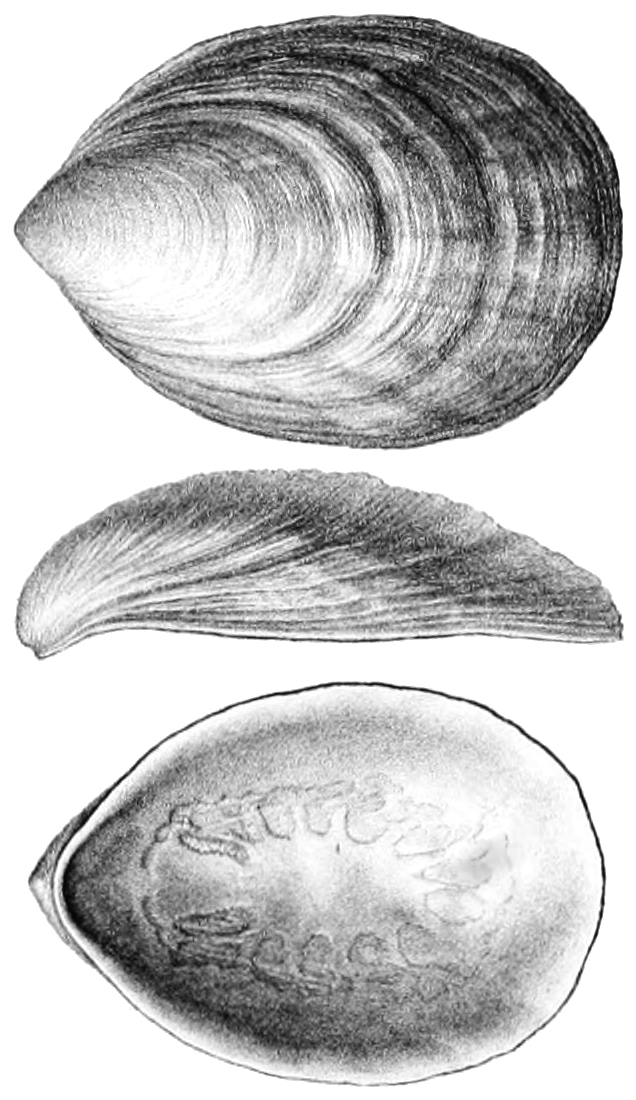|
Monoplacophoran
Monoplacophora , meaning "bearing one plate", is a polyphyletic superclass of molluscs with a cap-like shell inhabiting deep sea environments . Extant representatives were not recognized as such until 1952; previously they were known only from the fossil record, and were thought to have become extinct 375 million years ago. Although the shell of many monoplacophorans is limpet-like in shape, they are not gastropods, nor do they have any close relation to gastropods. Definition Discussion about monoplacophorans is made difficult by the slippery definition of the taxon; some authors take it to refer to all non-gastropod mollusks with a single shell, or all single-shelled mollusks with serially repeated units; whereas other workers restrict the definition to cap-shaped forms, excluding spiral and other shapes of shell. The inclusion of the gastropod-like Bellerophontoidea within the group is also contentious. One attempt to resolve this confusion was to separate out the predomin ... [...More Info...] [...Related Items...] OR: [Wikipedia] [Google] [Baidu] |
Tryblidiida
Tryblidiida is a taxon of monoplacophoran molluscans containing the only extant representatives: 37 species are still alive today, inhabiting the ocean at depths of between . History of discoveries The first captured living monoplacophoran was ''Veleropilina zografi'' in 1896, but at that time it was described as if it were an archaeogastropod, a true limpet, mainly because of its patelliform (limpet-like) shell. This species was finally revealed to be monoplacophoran 87 years later, in 1983. In April 1952, a living specimen was collected from deep depths in the Middle America Trench off Costa Rica's Pacific coast. In 1957 that species was described and named ''Neopilina galatheae'' by its discoverer, Danish biologist Henning Mourier Lemche (1904–1977). An expert in the field has called this discovery "one of the greatest sensations in the [twentieth] century."Schwabe, above, at p. 205. As of 2008, there were 31 living species known, discovered in waters from 200 meters in de ... [...More Info...] [...Related Items...] OR: [Wikipedia] [Google] [Baidu] |
Neopilina
''Neopilina'' is a highly derived genus of modern monoplacophoran.Organisms, Genes and Evolution: Evolutionary Theory at the Crossroads ; Proceedings of the 7th International Senckenberg Conference. By Dieter Stefan Peters, Michael Weingarten. Contributor: Dieter Stefan Peters. Published by Franz Steiner Verlag, 2000. , 9783515076593. 243 pages. Species * '' Neopilina bruuni'' Menzies, 1968 * '' Neopilina galatheae'' Lemche, 1957 * '' Neopilina rebainsi'' Moskalev, Starobogatov & Filatova, 1983 * ''Neopilina starobogatovi'' Ivanov & Moskalev, 2007 Phylogeny Some molecular results show that they fall within the polyplacophoran clade, although these results have been called into question. Fossil and morphological data show that they are rather derived and bear very little resemblance to an 'ancestral mollusc'. Anatomy Its anatomy led researchers to believe that the cephalopods evolved from the Monoplacophora. Its pair of preoral tentacles are considered homologous to those o ... [...More Info...] [...Related Items...] OR: [Wikipedia] [Google] [Baidu] |
Mollusc
Mollusca is the second-largest phylum of invertebrate animals after the Arthropoda, the members of which are known as molluscs or mollusks (). Around 85,000 extant species of molluscs are recognized. The number of fossil species is estimated between 60,000 and 100,000 additional species. The proportion of undescribed species is very high. Many taxa remain poorly studied. Molluscs are the largest marine phylum, comprising about 23% of all the named marine organisms. Numerous molluscs also live in freshwater and terrestrial habitats. They are highly diverse, not just in size and anatomical structure, but also in behaviour and habitat. The phylum is typically divided into 7 or 8 taxonomic classes, of which two are entirely extinct. Cephalopod molluscs, such as squid, cuttlefish, and octopuses, are among the most neurologically advanced of all invertebrates—and either the giant squid or the colossal squid is the largest known invertebrate species. The gastr ... [...More Info...] [...Related Items...] OR: [Wikipedia] [Google] [Baidu] |
Cyrtolitidae
Cyrtolitidae is an extinct family of monoplacophorans in the order Cyrtonellida. Genera * '' Cloudia'' * '' Cyclocyrtonella'' * '' Cyrtolites'' * '' Cyrtonellopsis'' * '' Kolihadiscus'' * '' Neocyrtolites'' * '' Paracyrtolites'' * '' Quasisinuites'' * '' Sinuella'' * '' Sinuitopsina'' * '' Sinuitopsis'' * '' Telamocornu'' * '' Yochelsonellis'' References External links * Prehistoric monoplacophorans Prehistoric mollusc families Ordovician first appearances Devonian extinctions {{Paleo-mollusc-stub ... [...More Info...] [...Related Items...] OR: [Wikipedia] [Google] [Baidu] |
Bellerophontoidea
Bellerophontoidea, common name "bellerophonts",Bouchet P. & Rocroi J.-P. (Ed.); Frýda J., Hausdorf B., Ponder W., Valdes A. & Warén A. 2005. ''Classification and nomenclator of gastropod families''. Malacologia: International Journal of Malacology, 47(1-2). ConchBooks: Hackenheim, Germany. . ISSN 0076-2997. 397 pp. http://www.vliz.be/Vmdcdata/imis2/ref.php?refid=78278 is a Taxonomic rank, superfamily of extinct planospirally-coiled globose molluscs. This superfamily is generally included within the Gastropoda, but may instead be a group of monoplacophorans. The taxon first appeared late in the Cambrian and continued until late in the Triassic. Biology Unlike normal gastropods, the shells of Bellerophonts are characterised by a completely planispiral pattern of coiling, such as one finds in shelled cephalopods. Experts disagree whether Bellerophontids should be classified as Torsion (gastropod), torted gastropods, or as untorted Tergomya, or whether the group Bellerophontida is ... [...More Info...] [...Related Items...] OR: [Wikipedia] [Google] [Baidu] |
Cyrtonellida
Cyrtonellida is a group of "monoplacophora", representing either a sister taxon to, or a polyphyletic assemblage including, the Trybliida. Subtaxa * Carcassonnellidae * Cyrtolitidae Cyrtolitidae is an extinct family of monoplacophorans in the order Cyrtonellida. Genera * '' Cloudia'' * '' Cyclocyrtonella'' * '' Cyrtolites'' * '' Cyrtonellopsis'' * '' Kolihadiscus'' * '' Neocyrtolites'' * '' Paracyrtolites'' * '' Quasisin ... * Cyrtonelloidea * Pollicinidae ; Genera * '' Aremellia'' * '' Hamusella'' * '' Tetamocornu'' * '' Yangtzeconus'' * '' Yochelsonia'' References External links * Prehistoric monoplacophorans Mollusc orders {{Paleo-mollusc-stub ... [...More Info...] [...Related Items...] OR: [Wikipedia] [Google] [Baidu] |

